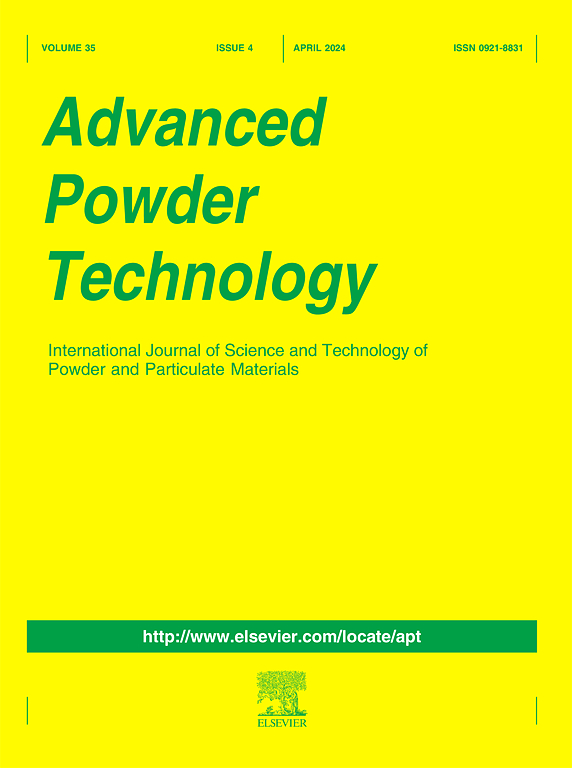Nanoparticle formation of β-carotene by mixing supercritical carbon dioxide antisolvent with liquefied dimethyl ether feed solution using swirl mixer
IF 4.2
2区 工程技术
Q2 ENGINEERING, CHEMICAL
引用次数: 0
Abstract
The production of β-carotene nanoparticles using non-toxic and environmentally-friendly liquefied dimethyl ether (DME) via a supercritical antisolvent (SAS) process, which produces no residue, is a major challenge in food processes. Preparations of nanoparticles have previously been conducted with toxic organic feed solvents. In this work, β-carotene was micronized with two feed solutions, liquefied DME and ethyl acetate, using a swirl mixer mixing in a turbulent field by the SAS method for comparison. The effects of operating pressure, temperature, and solution flow rate were investigated on the size of nanoparticles. Field-emission-scanning electron microscopy (FE-SEM) images showed that dispersed β-carotene nanoparticles, 43.9 nm in size, were successfully prepared at 40 °C and 8 MPa, and no residual DME was present in the nanoparticles. Using an ethyl acetate solution to precipitate β-carotene at 40 °C and 10 MPa and successfully obtained nanoparticles 62.12 nm in size. Compared to the previous study (12 MPa, normal nozzle), the smallest β-carotene particles precipitated from the optimal conditions of DME and ethyl acetate, respectively, were obtained at lower pressures and smaller particles with the swirl mixer. X-ray diffraction (XRD) and differential thermal analysis (DTA) confirmed that the obtained nanoparticles were amorphous. By contrast, residual ethyl acetate solution was present in the nanoparticles precipitated from ethyl acetate; this phenomenon was confirmed using Fourier transform infrared spectroscopy (FT-IR) and gas chromatography-mass spectrometry (GC–MS).

超临界二氧化碳抗溶剂与液化二甲醚饲料溶液旋流混合形成β-胡萝卜素纳米颗粒
利用无毒环保的液化二甲醚(DME)通过超临界抗溶剂(SAS)工艺生产β-胡萝卜素纳米颗粒是食品加工中的一个主要挑战,该工艺不会产生任何残留物。纳米颗粒的制备以前是用有毒的有机饲料溶剂进行的。本研究以液化二甲醚(DME)和乙酸乙酯(乙酯)两种进料溶液为原料,利用旋流混合器在紊流场中混合,采用SAS法进行了β-胡萝卜素的微粉化比较。研究了操作压力、温度和溶液流速对纳米颗粒尺寸的影响。在40℃、8 MPa条件下,成功制备了尺寸为43.9 nm的分散β-胡萝卜素纳米颗粒,纳米颗粒中没有二甲醚残留。采用乙酸乙酯溶液在40℃、10 MPa条件下沉淀β-胡萝卜素,成功获得尺寸为62.12 nm的纳米颗粒。与之前的研究(12 MPa,普通喷嘴)相比,在较低的压力和较小的颗粒下,分别从二甲醚和乙酸乙酯的最佳条件下得到了最小的β-胡萝卜素颗粒。x射线衍射(XRD)和差热分析(DTA)证实所制备的纳米颗粒为非晶态。相比之下,乙酸乙酯沉淀的纳米颗粒中存在残留的乙酸乙酯溶液;傅里叶变换红外光谱(FT-IR)和气相色谱-质谱(GC-MS)证实了这一现象。
本文章由计算机程序翻译,如有差异,请以英文原文为准。
求助全文
约1分钟内获得全文
求助全文
来源期刊

Advanced Powder Technology
工程技术-工程:化工
CiteScore
9.50
自引率
7.70%
发文量
424
审稿时长
55 days
期刊介绍:
The aim of Advanced Powder Technology is to meet the demand for an international journal that integrates all aspects of science and technology research on powder and particulate materials. The journal fulfills this purpose by publishing original research papers, rapid communications, reviews, and translated articles by prominent researchers worldwide.
The editorial work of Advanced Powder Technology, which was founded as the International Journal of the Society of Powder Technology, Japan, is now shared by distinguished board members, who operate in a unique framework designed to respond to the increasing global demand for articles on not only powder and particles, but also on various materials produced from them.
Advanced Powder Technology covers various areas, but a discussion of powder and particles is required in articles. Topics include: Production of powder and particulate materials in gases and liquids(nanoparticles, fine ceramics, pharmaceuticals, novel functional materials, etc.); Aerosol and colloidal processing; Powder and particle characterization; Dynamics and phenomena; Calculation and simulation (CFD, DEM, Monte Carlo method, population balance, etc.); Measurement and control of powder processes; Particle modification; Comminution; Powder handling and operations (storage, transport, granulation, separation, fluidization, etc.)
 求助内容:
求助内容: 应助结果提醒方式:
应助结果提醒方式:


